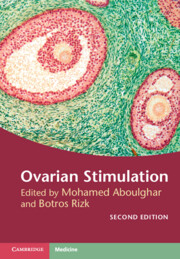Book contents
- Ovarian Stimulation
- Ovarian Stimulation
- Copyright page
- Dedication
- Contents
- Contributors
- About the Editors
- Foreword
- Preface to the first edition
- Preface to the second edition
- Section 1 Mild Forms of Ovarian Stimulation
- Section 2 Ovarian Hyperstimulation for IVF
- Section 3 Difficulties and Complications of Ovarian Stimulation and Implantation
- Section 4 Non-conventional Forms Used during Ovarian Stimulation
- Section 5 Alternatives to Ovarian Hyperstimulation and Delayed Transfer
- Chapter 23 Hyperprolactinemia
- Chapter 24 Ovarian Cautery for Polycystic Ovary Syndrome
- Chapter 25 Elective Freeze-All Embryos Policy
- Section 6 Procedures before, during, and after Ovarian Stimulation
- Index
- References
Chapter 24 - Ovarian Cautery for Polycystic Ovary Syndrome
from Section 5 - Alternatives to Ovarian Hyperstimulation and Delayed Transfer
Published online by Cambridge University Press: 14 April 2022
- Ovarian Stimulation
- Ovarian Stimulation
- Copyright page
- Dedication
- Contents
- Contributors
- About the Editors
- Foreword
- Preface to the first edition
- Preface to the second edition
- Section 1 Mild Forms of Ovarian Stimulation
- Section 2 Ovarian Hyperstimulation for IVF
- Section 3 Difficulties and Complications of Ovarian Stimulation and Implantation
- Section 4 Non-conventional Forms Used during Ovarian Stimulation
- Section 5 Alternatives to Ovarian Hyperstimulation and Delayed Transfer
- Chapter 23 Hyperprolactinemia
- Chapter 24 Ovarian Cautery for Polycystic Ovary Syndrome
- Chapter 25 Elective Freeze-All Embryos Policy
- Section 6 Procedures before, during, and after Ovarian Stimulation
- Index
- References
Summary
The term “polycystic ovary syndrome” (PCOS) has replaced the term Stein–Leventhal syndrome. Stein and Leventhal not only were the first to describe the condition but also developed and reported on a treatment, reporting on a successful series of 108 women treated by “wedge resection” [1]. In fact until the availability of clomiphene (clomifene) citrate (CC) in 1961 [2], this was the only option available to treat the infertility of women with this condition; characterized by obesity, oligomenorrhea, and anovulation. However, as treatment required laparotomy, and often resulted in periovarian adhesion formation, once medical treatment was available, initially CC, then human pituitary gonadotropins (hPG) [3], then urinary human menopausal gonadotropin (hMG) [4], wedge resection lost popularity, unless it was performed in conjunction with another surgical procedure that already required laparotomy.
- Type
- Chapter
- Information
- Ovarian Stimulation , pp. 245 - 254Publisher: Cambridge University PressPrint publication year: 2022

